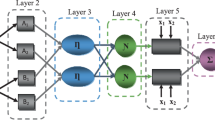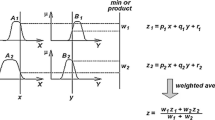Abstract
The aim of this study was to compare the response surface regression and adaptive neuro-fuzzy models for predicting the compressed air consumption in air jet weaving. The prediction models are based on the experimental data of 100 samples comprising weft yarn count, fabric width, loom speed and reed count as input variables and compressed air consumption as output/response variable. The models quantitatively characterize the linear and quadratic relationships as well as interactions between the input and output variables exhibiting very good prediction ability and accuracy, with ANFIS model being slightly better in performance than the regression model. The models could be used for estimating the compressed air consumption, identifying air leakages and production planning in a weaving mill.
Similar content being viewed by others
References
M. Ishida and A. Okajima, Text. Res. J., 64, 10 (1994).
M. Ishida and A. Okajima, Text. Res. J., 64, 88 (1994).
S. Y. Jeong, K. H. Kim, J. H. Choi, and C. K. Lee, Int. J. Kor. Soc. Prec. Eng., 6, 23 (2005).
Ö. Göktepe and O. Bozkan, Text. Res. J., 78, 816 (2008).
A. Masuda, Y. Sogi, and N. Ogata, J. Text. Mach. Soc. Japan., 52, T9 (1999).
G. Belforte, G. Mattiazzo, F. Testore, and C. Visconte, Text. Res. J., 81, 791 (2011).
H. W. Krause, Mell. Text. (Eng. Ed.), 61, 789 (1980).
A. Wahhoud, Mell. Text. (Eng. Ed.), 64, 257 (1983).
U. Kissling, Mell. Text. (Eng. Ed.), 66, 104 (1985).
O. Colak and M. Kodaloglu, Fib. & Text. East. Eur., 12, 47 (2004).
J. Githaiga, L. Vangheluwe, and P. Kiekens, J. Text. Inst., 91, 35 (2000).
Z. A. Malik, M. H. Malik, T. Hussain, and A. Tanwari, Ind. J. Fib. Text. Res., 35, 310 (2010).
A. Majumdar, P. K. Majumdar, and B. Sarkar, J. Text. Inst., 96, 55 (2005).
N. Ucar and S. Ertugrul, Text. Res. J., 72, 361 (2002).
D. Nurwaha and X. H. Wang, Fiber. Polym., 9, 782 (2008).
J. Ju and H. Ryu, Fiber. Polym., 7, 203 (2006).
A. Majumdar, M. Ciocoiu, and M. Balga, Fiber. Polym., 9, 210 (2008).
Author information
Authors and Affiliations
Corresponding author
Rights and permissions
About this article
Cite this article
Hussain, T., Jabbar, A. & Ahmed, S. Comparison of regression and adaptive neuro-fuzzy models for predicting the compressed air consumption in air-jet weaving. Fibers Polym 15, 390–395 (2014). https://doi.org/10.1007/s12221-014-0390-x
Received:
Revised:
Accepted:
Published:
Issue Date:
DOI: https://doi.org/10.1007/s12221-014-0390-x




